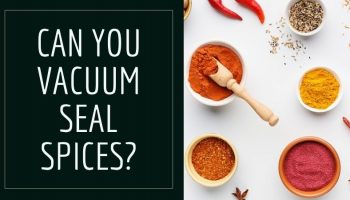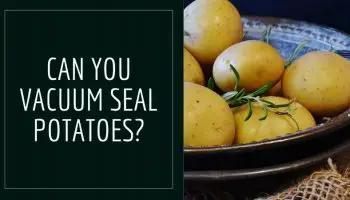I must confess that when I first got my first vacuum sealer, it was to seal meat in bags. I had grown tired of buying meat piecemeal at retail prices, you see.
And then I didn’t particularly care for meat that has suffered freezer burn. That all changed with my first vacuum sealer.
Suddenly, I was able to buy meat in bulk, since the vacuum sealed met last much longer. What’s more, the vacuum seal prevented the dreaded freezer burn from occurring, so the meat retained their glorious flavor.
Then I found myself vacuuming sealing just about everything. Leftovers and even bags of chips were protected this way. I kept experimenting with various food items, and I also tried out the other features offered by my vacuum sealer.
So I tried using jars instead of bags for my food, and it was a revelation. In some cases, it was better than using vacuum seal bags.
Picking Your Equipment
I must confess that when I started out using jars, I went at it the wrong way. I had a lot of jars, and so I initially tried to find the vacuum sealers that allowed me to use the jars I already had.
Eventually, I discovered that it’s better to first pick the right vacuum sealer for my needs. I just needed to pick one that really worked with jars. The best ones already come with the attachments for the jars, but you can buy these attachments easily enough.
You’ll also need an air extraction tube that connects your attachment to the jar. This tube is a hose you connect to the vacuum port on one end. The other end is connected to the attachment that you fit into your jar lid.
When I found the vacuum sealer and the attachments, that’s when I bought the jars. Usually, these attachments are either in regular jars or for wide-mouth jars.
Prepare Your Jar for Sealing
Usually, I end up using a Mason jar for this sort of thing, although of course, you can pick your own jars. You can start by cleaning it properly so that the lid and the rim can really form a tight seal. Next, fill up the jar with the food you want to store.
You need to make sure you leave about an inch of space at the top. This space is crucial for several reasons. It keeps your vacuum sealer from wearing down. It prevents some food items like dry or powdery food from getting into the vacuum hose.
Space is also great if you’re putting liquid items in a jar since the liquid has enough space to expand or contract as the temperature changes.
One the jar is filled appropriately, just cover the mouth of the jar with the flat lid. Just put aside the metal ring for later use.
Attach the Jar Sealing Attachment
Connecting this attachment is actually very simple. But that’s only true if you’re using the right attachment for the jar. To connect the attachment correctly, you have to push it down over the covered mouth of the jar.
You have to push down until you can no longer see the neck of the jar. When this is done, the attachment should stay snugly in its place.
Now it’s time to connect the air extraction hose to the sealing attachment on one end and the vacuum sealer on the other end. You have to make sure that in both ends you have a nice tight fit so no pressure or air can escape.
You should push it as far as it will go when you’re connecting it to your vacuum sealer. If you have a leak, you won’t get the air out of the jar completely. That can leave the food inside susceptible to spoiling.
Vacuum Sealing the Jar
Once all the necessary preparations have been done, it’s time to finally seal the jar. Turn on the vacuum sealer, and then use it to seal the jar according to its instructions.
Many of the modern vacuum sealers can do this very well especially in automatic mode. They complete the seal on their own without any real effort from you.
But you can still use your manual models for this task. Usually, you just need to monitor the jar for any popping sound. That’s the sound that signifies that the jar has been properly sealed.
When you hear it, just switch off the vacuum sealer right away. Remove the attachment, and then use the metal ring seal around the top of the jar. You’re now ready to store the jar in your refrigerator.
- For use with wide-mouth standard size mason-type jars and lids
- Re-vacuums jars easily. Plastic air tube not included
- Great for liquids, sauces, fragile foods and dry goods
- Air-tight and odor proof
Using Atypical Jars
Now if you insist on using atypical jars, this too can be accommodated. However, what you’ll need is a special large canister that comes with vacuum sealing attachment features in the lid. You’ll then put the atypical jar inside this canister.
In this process, you should prepare the jar the same way, except you should screw the lid in but you don’t do it tightly. Then you connect the canister to the vacuum sealer in the usual way.
Once you’re done removing the air inside the canister, you can then press the special depressurize button on the canister. This enables the flow of air back into the canister, and it completes the process of sealing the jar inside the canister.
What If The Jar Won’t Seal?
This can be frustrating, so check for the following factors that may be preventing a tight seal:
- If you’re using a standard vacuum sealer, make sure your hose is attached to both the vacuum sealer and the jar attachment securely.
- Press more firmly on the attachment if you’re using a handheld sealer.
- Make sure you use the vacuum sealer long enough to actually vacuum all the air out. Usually, the motor will slow down slightly when you’re done.
- Check to see if the lid is bent.
- Inspect the rim of the jar for chips or cracks.
- There may also be some design irregularities near the rim that prevent a tight seal.
- Check if the hole in the attachment is blocked by some food particles. This happens often with powdery food. You can use a coffee filter to prevent this.
- Clean the lid and the rim of the jar so you remove any food particles
- The rubber gasket on the attachment may be dirty, so wash it in soapy water.
- Make sure the jar you’re using actually matches with your attachment.
Frequently Asked Questions (FAQs)
Q: Where can I store my jar after vacuum sealing?
A: It’s very tempting to just put the jars in a cabinet, but that’s ultimately unwise. If you’re trying to preserve any sort of perishable food, then you still need to put the jars in the refrigerator.
The only time you can put the jar in a cabinet is when you’ve put in something non-perishable, such as a special memento you wish to keep in a secure place.
Q: Can I use jars to store dry ingredients used for baking?
A: Yes, that would be ideal. You can use it for flour, sugar, brown sugar, baking powder and soda, graham cracker crumbs, and cornstarch. For grainy items, you may want to put a coffee filter inside so the powder doesn’t get into the seal or the sealer.
Q: What other food items can I place in a jar?
A: You can also store and preserve other dry goods. These can include cereal, coffee grounds, nuts, beans, and pasta. In some cases, I even use it for peppercorns and fruit.
Q: What’s easier for vacuum sealing, a regular or a wide-mouth jar?
A: I’ve found wide-mouth jars much easier to seal, so I tend to use it more frequently. Also, the wider opening makes it easier to put the food in and take it out. Cleaning the inside of the jar is also easier.
Q: What else can I do to preserve the shelf life of the food in the jars?
A: You can try to use oxygen absorbers inside before capping the jar.
Recommended Vacuum Sealer
| # | Preview | Product | Price | |
|---|---|---|---|---|
| 1 |

|
Chef Preserve Vacuum Sealer (Vacuum... | $99.00 | Buy on Amazon |
| 2 |

|
2023 Updated Vacuum Sealer Machine,... | $25.10 | Buy on Amazon |
| 3 |

|
Nesco Deluxe Food VS-12 Vacuum Sealer,... | $114.57 | Buy on Amazon |
| 4 |

|
FRESKO Smart Vacuum Sealer Pro, Full... | $79.91 | Buy on Amazon |
| 5 |

|
Pyukix Vacuum Sealer Machine, Food... | $89.99 | Buy on Amazon |
Final Verdict
What you have to understand is that vacuum sealed jars aren’t as effective as canned jars. The vacuum sealed jars only keep the air out, but they don’t guarantee that the food inside will remain sterile in the long run. With canning methods, the food inside actually remains sterile.
Still, using the jars has its benefits. It keeps the food inside fresh for a far longer period of time. The jars are easier to store in the fridge, and it prevents freezer burn. It also protects the food inside from various hazards.
You won’t have to worry about ants and other pests, along with such dangers as humidity, oxygen, heat, and light.
As a bonus, I’ve found that these jars are great when I want to keep some foods from my kids! It’s a particularly effective child-proof lock. So I use jars to keep my energy bars and granola bars.
Before, they keep dwindling in number suspiciously, while my kids try out their poker faces. Now those days of pilferage are over!




![Can You Vacuum Seal Tomatoes? [The Proper Way!]](https://vacuumsealerzone.com/wp-content/uploads/2021/08/Can-You-Vacuum-Seal-Tomatoes-350x200.jpg)
Great tips and tricks! Thanks for sharing, lisa! I Love my foodsaver!
I recently discovered a really great vacuum sealing product on amazon that doesn’t require any electricity or batteries. It’s called the pump-n-seal and it works really well on glass mason jars!